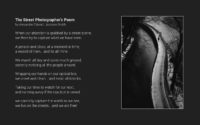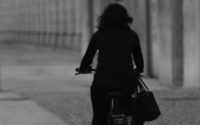Analogue is Left but Digital is Right?
This article was posted on petapixel and interestingly the comments to the article suggest to me that no one reads any more. I think for the purposes of clarity I need to take the last comment and place it at the top…
Is this only personal, a left handed thing or a “creative something” that could impact all photographers? I don’t know but I think we need to test and debate this!
Having learnt photography in the time of manual analogue film cameras, I know digital feels different. And for me it’s all about the Left and Right of Photography.
Analogue photography is predominantly a left handed pursuit but digital is predominantly right handed. The question that begs to be asked is “what influence does this have on creativity?”. More importantly; “your images!”.
I personally find that the right hand operation of shutter and aperture makes for a rather clumsy interface. I suspect however, that being left-handed is only part of the reason.
Left and Right of Photography Ergonomics
Digital cameras often use the right-hand for both carrying and to change aperture and shutter settings. The “index finger/thumb” wheel and the other settings buttons are for the right-hand on most digital cameras. Leica and Fuji are different, and we will come to that. But this general modern design requires a strength and dexterity that is unnecessary considering the left hand is so under employed.
Creativity, Artistic and Technical
Whilst the jury is still out on left or right brain dominance, there is a general acceptance that different brain halves are effective in different tasks. Indeed studies on people with brain damage have reinforced the abilities being oriented in this way. Disputed is mostly the belief that we are either/or in our thinking and not that the brain has separation.
Other studies have shown that people, with brain damage, being asked to select objects from a bag can sometimes not even know what they have chosen. This led the researchers to deduce that communication between the analytical and abstract areas are distinct and independent.
This all may or may not be true, the whole story or not even close. But one has to ask has anyone in the mainstream photography companies checked?
Have they tested the artistic composition with photographers on the two very different systems?
Perhaps this is a little unfair, but it seems that the mainstream companies are tripping over themselves to meet the features and megapixel counts. They are ignoring the most important component in photography, the photographer!
Composition and an artistic eye seem to count for so little in todays post production and spray and pray photography. Yet even if this left-hand influence affords a slight increase in artistic influence it could give us the edge.
Leica/Fuji/Analogue retaining the Lefty Way!
Surprising in the modern photographic world is the persistence of Leica in retaining much of the older approach. More surprising is the fact that they still have a dedicated following. Fujifilm cameras similarly have focus and aperture left handedly. Older film cameras from other manufacturers are also facing a strong resurgence and appreciation.
Many will point out that most other digital cameras allow the left hand to control aperture and focus. However the aperture control and focus go round and round without any tactile confirmation of position. The feeling in the fingers for the end stops and clicks are missing and automation in these cameras is the expected norm.
Cameras with a retention or reassertion of the lefty way can’t all be because of the visuals, cost, weight or effort with film usage. There must be some artistic and ergonomic benefit. It appears to me that most people using these cameras are artists.
Is this the “secret” to the Leica/Fuji/Analogue following?
Affordable digital lefty system
Like me, most will be faced with a cold hard reality that a Leica with the glass is an unaffordable dream. The best I have come up with is a Nikon DSLR with the older AIS lenses; wonderful glass and the combination needs no adapter. This gives me the engagement and immersion that I so sorely missed with affordable automated digital camera setups.
Fujifilm’s X100, and others cameras, also provide the more traditional hand balance. Interestingly I feel as comfortable and creative with my fathers X100 as I do with my hybrid Nikon setup.
Hybrid digital-analogue lefty based digital setups can be created from Canon, Sony and the others too. So individual manufacturer preferences are by no means restricting a little personal experimentation. Best of all is the cost to experiment is actually cheap. Good manual legacy glass and an adapter for under $100 is realistic.
So does it affect pictures?
Clearly this question is only open to those who try and compare. With my personal experience of both manual analogue and modern digital I can say, for my creativity and images it does. I feel more engaged, immersed and connected with my subject. I am also happier with the composition and timing in my portrait, street and event photography, something I find difficult with a right-hand dominant camera.
Is this only personal, a left handed thing or a “creative something” that could impact all photographers? I don’t know but I think we need to test and debate this!



